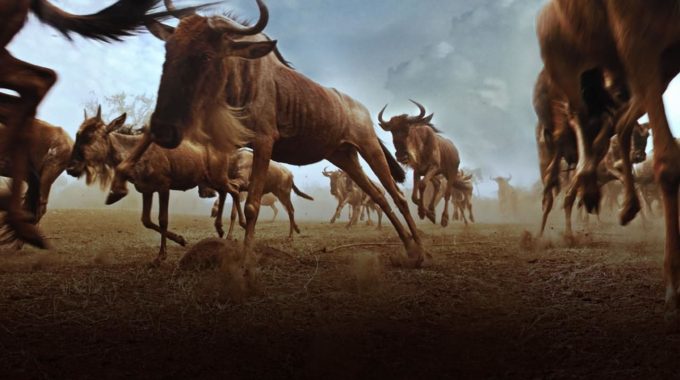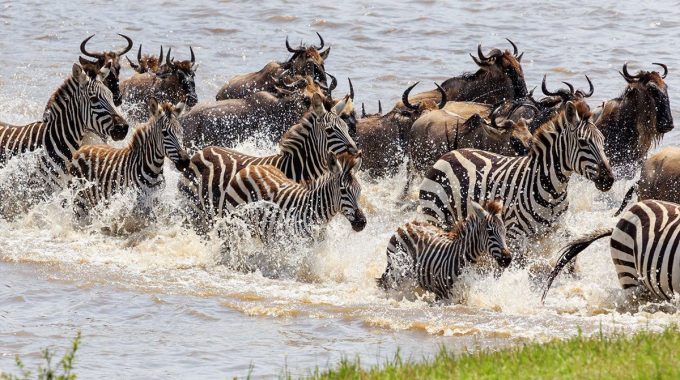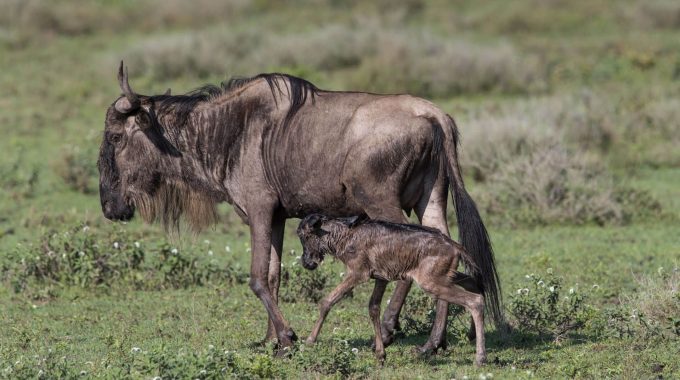How fast do wildebeest reproduce? - Wildebeests (Connochaetes spp.) are iconic members of the African savannas…
What eats wildebeests?
What eats wildebeests? – In Kenya and Tanzania, wildebeests (also known as gnus) are a key part of the ecosystem and form an important food source for many predators. These herbivores are typically found in large herds, particularly in the savannas and grasslands of the Serengeti-Mara ecosystem. The major predators that hunt wildebeests in this region include large carnivores like lions, leopards, cheetahs, hyenas, and crocodiles. Let’s dive into the specifics of each:

1. Lions (Panthera leo)
Lions are among the primary predators of wildebeests in Kenya and Tanzania, especially in the Serengeti and Maasai Mara. They are social animals and often hunt in groups (prides), which gives them an advantage over large prey like wildebeests.
- Hunting strategy: Lions often target young, sick, or isolated individuals, though they may also take down healthy adults. They typically hunt at night or early in the morning, using stealth to get close to their prey before launching an attack. Lionesses do most of the hunting, while males may assist during the final stages of the kill.
- Hunting success: A group of lions can often take down a wildebeest due to their teamwork and strength, but it’s still a dangerous task. Wildebeests are strong and can put up a fight, using their horns to defend themselves.
2. Spotted Hyenas (Crocuta crocuta)
Hyenas are another major predator of wildebeests. Known for their intelligence and scavenging ability, spotted hyenas often hunt in packs and are capable of bringing down large prey.
- Hunting strategy: Hyenas tend to hunt in groups and are opportunistic predators. They often target younger or weaker wildebeests, but they can also go after healthy adults, particularly if they work together. In some cases, hyenas will chase down wildebeests over long distances, using their endurance to exhaust them.
- Scavenging: In addition to hunting, hyenas are also skilled scavengers, and they will often steal kills from lions or other predators. Their powerful jaws and strong bite allow them to consume parts of the wildebeest carcass that other predators can’t.
3. Cheetahs (Acinonyx jubatus)
Cheetahs are fast runners and are the fastest land animals in the world. While they are not as powerful as lions or hyenas, they rely on speed and agility to catch their prey.
- Hunting strategy: Cheetahs typically hunt alone and rely on their speed to chase down and catch wildebeests. They target young, sick, or weaker animals, often attempting a surprise sprint of 100-200 meters to catch their prey. Once they catch the wildebeest, they aim for a swift neck bite to suffocate or immobilize the animal.
- Hunting success: Cheetah hunts are often successful, but the chase requires a lot of energy, and they can only maintain their top speed for short distances. If they fail to make the kill quickly, they may lose the prey to other predators like lions or hyenas.
4. Leopards (Panthera pardus)
Leopards are opportunistic hunters and typically target smaller prey, but they will also go after wildebeests, especially young or weak individuals.
- Hunting strategy: Leopards usually hunt alone and rely on stealth to approach their prey. They may ambush wildebeests from the trees or thick brush, using their ability to climb to evade competition from larger predators. While they generally focus on smaller ungulates, leopards have been known to take down juvenile wildebeests if the opportunity arises.
- Scavenging: Leopards are often more focused on stealth than on direct competition with larger predators, and they will sometimes scavenge from other kills.
5. Nile Crocodiles (Crocodylus niloticus)
In regions with water bodies, particularly in areas like the Mara River in Kenya or the Grumeti River in Tanzania, Nile crocodiles are significant predators of wildebeests, especially during the annual wildebeest migration.
- Hunting strategy: Nile crocodiles are ambush predators. They wait in the water for prey to approach, then lunge out to seize their prey with powerful jaws. During the migration, wildebeests often cross rivers, and crocodiles lie in wait for the herd to approach. The strong current and the stress of migration often leave wildebeests vulnerable to crocodile attacks.
- Hunting success: Crocodiles are highly effective during river crossings, where they can drag wildebeests into the water. The kill is often slow, as the crocodile drowns the prey or inflicts fatal injuries before beginning to consume it.
6. African Wild Dogs (Lycaon pictus)
Although less common than other predators like lions and hyenas, African wild dogs are skilled hunters and will target wildebeests, particularly younger or weaker individuals.
- Hunting strategy: Wild dogs hunt in packs, and their strength lies in cooperation. They often chase prey over long distances, wearing down the wildebeest before making a coordinated attack. They tend to go after the most vulnerable individuals, which are often young or injured wildebeests.
- Hunting success: Wild dogs are known for their persistence and endurance, and their hunts can be very successful due to their team-based strategies.
7. Vultures and Other Scavengers
While not direct predators, vultures and other scavengers play an important role in the ecosystem by cleaning up after a kill.
- Feeding behavior: After a predator has made a kill, vultures, jackals, and smaller scavengers will move in to feed on the remains. Vultures are particularly efficient in consuming the carcasses, and they often arrive quickly after a kill to pick the bones clean.
Summary of Predator Dynamics:
- Lions and hyenas are the main predators, often competing for the same prey.
- Cheetahs and leopards primarily hunt weaker or younger wildebeests, using speed and stealth respectively.
- Crocodiles exploit the vulnerability of wildebeests during river crossings.
- African wild dogs also target wildebeests, relying on teamwork and endurance.
- Scavengers like vultures and jackals often clean up after other predators.
Vulnerability:
Wildebeests are particularly vulnerable during the Great Migration when they have to cross rivers, face exhaustion, and are under constant pressure from predators. However, when in the safety of the herd, wildebeests have a better chance of defending themselves against predators, as their collective strength makes it harder for a predator to single out an individual.
Despite their strength and speed, wildebeests are still an important food source for many animals in the African savanna, and their migrations serve as a critical part of the predator-prey dynamics in the Serengeti and Maasai Mara ecosystems.



